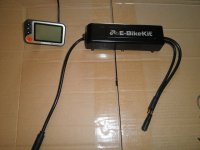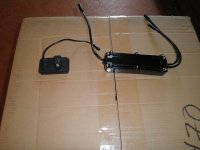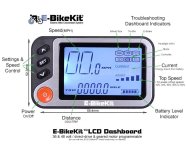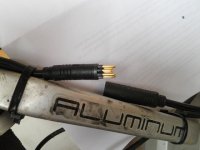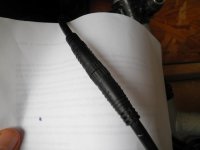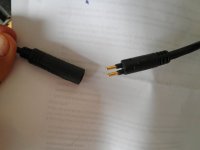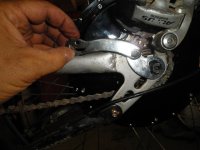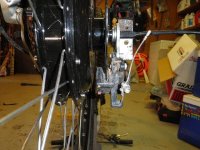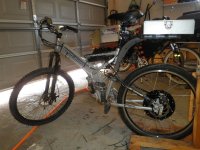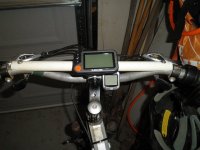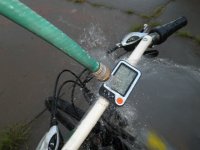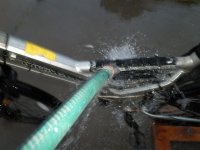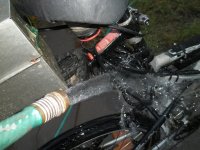dogman dan
1 PW
This is a review of the newest version of the E-BikeKit direct drive rear motor kit. View attachment 3
The kit was sent to me free by the company, but they full well know that I will try my best to destroy it without modifying it, and then tell all. It's a long way from being like they bought a favorable review. Since its free to me, I can do things I would never want to try with a kit I paid for. Muahahha!
I did a review of the similar kit some years ago, and failed to kill it. Jason just felt like it was time for me to see his latest improvements to the venerable 28mm rotor direct drive motor kit. So far, I've been very favorably impressed with it.
What motor is it? I don't know who in china manufactures the motor, but it's not the same crude "old design" hubmotor still seen today on ebay for cheap prices. The old design is not disk ready, and in the rear wheel version the hub has a lot of dish in the spokes which makes it a weaker wheel. It's virtually identical to a 9 continent brand motor. There are numerous producers of this "newer design" motor.
The new E-BikeKit design is a direct drive motor, with bolt on disk brake rotor mounts and little or no dishing of the spokes. It has no internal gears or clutch. Only 3 moving parts, the magnet rotor and two axle bearings. Simple and reliable. It has a 28mm width, and the diameter of the rotor is about 9 inches. So think dinner plate or pie pan size. I think of this motor type as a medium size bike motor. The E-BikeKit's standard model is a 7 turn winding motor. They now come with a better than average rim with spoke eyelets, and are built and trued at the shop in the USA.
What controller is it? Though a new design, the controller is still similar in power to the old dd kit controller. 22 amps is what I measure with a wattmeter. It includes brake cutoff and throttle connections. New is the dashboard, with speedo and 5 power level selections.
Ratings by number of stars.
* It's ok, functional
* * Average good
* * * Very good
* * * * As good as it gets, Exceptional
Shipping Time. * * * *
Shipping time was about a week. Normal for things ordered from a shipper in the USA, to my address in the USA. I live across the continent from the shop, so my shipping time is about the max.
The Box. * * *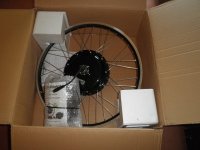
The box arrived with no visible damage, but when I opened it, I saw changes to how it was packed. Less foam, and in particular lacking the foam circles that help protect the axle from poking right through the box. We all prefer to see our stuff shipped with overkill packing, but the fact is, the motor arrived in perfect condition. The excellent rubber bumpers on the axle ends did a great job of protecting the axle threads and wiring. Actually, two kits were sent, and BOTH arrived in perfect condition. What can you say, perfect is as good as it gets eh?
What you get in the Box. * * * *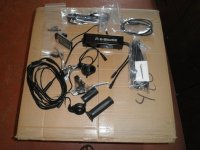
It's a VERY complete kit. I did not get a battery, but in addition to the motor itself, all this comes with the motor kit. Starting at the top left,,,
Wiring harness, one bag is for the dashboard and brakes, the other battery to controller.
Controller dashboard , controller, and bag of zip ties, one torque arm, two C washers, and two allen wrenches.
Bottom row, More wire harness, one thumb throttle, one half twist throttle, brake levers, and grips.
Every kit has both throttles. 8)
You get a very good, very complete instruction manual. It's a LOT better than running back inside to look again at the computer. It's in your hand, in the garage. You could carry it with you if you like. It's Written in English. Not translated by a machine. 8)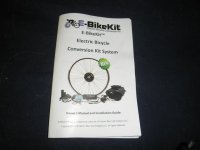
My box also had a black E-BikeKit tee shirt.
Installation. * * * *
I had no big problems to solve installing this kit. It's complete, and fits a standard seven speed rear shifter bike very well. No major problems getting the disk brake lined up. Just a matter of fiddling a bit with the supplied washers, to get the disk aligned with the caliper. Once the disk lined up the rear wheel also lined up. No need for disk rotor spacers or re dishing the wheel.
I always get a laugh when I see "installs and be riding in 30 min" in some ads. I suppose it's possible, but I tend to be more careful and take at least an hour to get a tire on the motor, get the motor, controller and throttle installed, and all the wires tidied up with the zip ties. And that is after the many times I've done this.
Then, depending on how you will carry your battery, that can be a rather large project. But if the battery is ready to go, you should be riding in less than two hours. It's not that hard to install on most bikes. But if you insist on using a less compatible bike, like one with 27 speeds, then you may have some more time involved changing the chain and shifters. This rear motor kit comes with a 7 speed rear freewheel on it. Front motor kits would of course come without any gears.
I had a minor problem with the dashboard. My handlebars have more than the usual amount of upsweep, so installing the dashboard was not perfect. The dash board mount is simple, and does not allow adjustment. So it had to be crammed in pretty tight. A very small problem, which I fixed later. More about how I did that later. View attachment 1
The kit was sent to me free by the company, but they full well know that I will try my best to destroy it without modifying it, and then tell all. It's a long way from being like they bought a favorable review. Since its free to me, I can do things I would never want to try with a kit I paid for. Muahahha!
I did a review of the similar kit some years ago, and failed to kill it. Jason just felt like it was time for me to see his latest improvements to the venerable 28mm rotor direct drive motor kit. So far, I've been very favorably impressed with it.
What motor is it? I don't know who in china manufactures the motor, but it's not the same crude "old design" hubmotor still seen today on ebay for cheap prices. The old design is not disk ready, and in the rear wheel version the hub has a lot of dish in the spokes which makes it a weaker wheel. It's virtually identical to a 9 continent brand motor. There are numerous producers of this "newer design" motor.
The new E-BikeKit design is a direct drive motor, with bolt on disk brake rotor mounts and little or no dishing of the spokes. It has no internal gears or clutch. Only 3 moving parts, the magnet rotor and two axle bearings. Simple and reliable. It has a 28mm width, and the diameter of the rotor is about 9 inches. So think dinner plate or pie pan size. I think of this motor type as a medium size bike motor. The E-BikeKit's standard model is a 7 turn winding motor. They now come with a better than average rim with spoke eyelets, and are built and trued at the shop in the USA.
What controller is it? Though a new design, the controller is still similar in power to the old dd kit controller. 22 amps is what I measure with a wattmeter. It includes brake cutoff and throttle connections. New is the dashboard, with speedo and 5 power level selections.
Ratings by number of stars.
* It's ok, functional
* * Average good
* * * Very good
* * * * As good as it gets, Exceptional
Shipping Time. * * * *
Shipping time was about a week. Normal for things ordered from a shipper in the USA, to my address in the USA. I live across the continent from the shop, so my shipping time is about the max.
The Box. * * *

The box arrived with no visible damage, but when I opened it, I saw changes to how it was packed. Less foam, and in particular lacking the foam circles that help protect the axle from poking right through the box. We all prefer to see our stuff shipped with overkill packing, but the fact is, the motor arrived in perfect condition. The excellent rubber bumpers on the axle ends did a great job of protecting the axle threads and wiring. Actually, two kits were sent, and BOTH arrived in perfect condition. What can you say, perfect is as good as it gets eh?
What you get in the Box. * * * *

It's a VERY complete kit. I did not get a battery, but in addition to the motor itself, all this comes with the motor kit. Starting at the top left,,,
Wiring harness, one bag is for the dashboard and brakes, the other battery to controller.
Controller dashboard , controller, and bag of zip ties, one torque arm, two C washers, and two allen wrenches.
Bottom row, More wire harness, one thumb throttle, one half twist throttle, brake levers, and grips.
Every kit has both throttles. 8)
You get a very good, very complete instruction manual. It's a LOT better than running back inside to look again at the computer. It's in your hand, in the garage. You could carry it with you if you like. It's Written in English. Not translated by a machine. 8)

My box also had a black E-BikeKit tee shirt.
Installation. * * * *
I had no big problems to solve installing this kit. It's complete, and fits a standard seven speed rear shifter bike very well. No major problems getting the disk brake lined up. Just a matter of fiddling a bit with the supplied washers, to get the disk aligned with the caliper. Once the disk lined up the rear wheel also lined up. No need for disk rotor spacers or re dishing the wheel.
I always get a laugh when I see "installs and be riding in 30 min" in some ads. I suppose it's possible, but I tend to be more careful and take at least an hour to get a tire on the motor, get the motor, controller and throttle installed, and all the wires tidied up with the zip ties. And that is after the many times I've done this.
Then, depending on how you will carry your battery, that can be a rather large project. But if the battery is ready to go, you should be riding in less than two hours. It's not that hard to install on most bikes. But if you insist on using a less compatible bike, like one with 27 speeds, then you may have some more time involved changing the chain and shifters. This rear motor kit comes with a 7 speed rear freewheel on it. Front motor kits would of course come without any gears.
I had a minor problem with the dashboard. My handlebars have more than the usual amount of upsweep, so installing the dashboard was not perfect. The dash board mount is simple, and does not allow adjustment. So it had to be crammed in pretty tight. A very small problem, which I fixed later. More about how I did that later. View attachment 1


